Early Life
- Theodore Herman Albert Dreiser was born in 1871 in Terre Haute, Indiana, to a devout Catholic German immigrant father and a mother from Mennonite Community.
- He was the twelfth of thirteen children in an impoverished family (ninth of ten surviving children).
- His father, John Paul Dreiser, suffered from devastating financial loss and physical injury due to a fire in his wool mill. Her mother, Sarah Schnaab, was kind and tolerant of unconventional behavior.
- He left home when he was 16 and worked at several jobs.
- Dreiser graduated from high school in Warsaw, Indiana.
- He spent the year 1889-1990 at Indiana University.
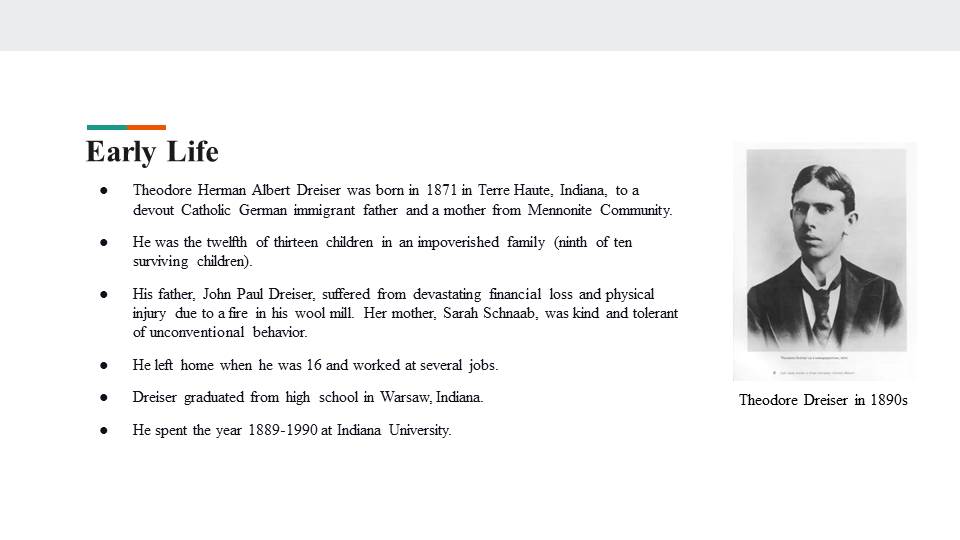
Middle Life
- 1890-1900: He worked at various low-level jobs in Chicago and began his career as a newspaperman, became a reporter at St. Louis Republic, Dispatch, editor of Ev’ry Morning, married Sara White (Pizer XV-XIX).
- 1901:1911: Dreiser had a nervous breakdown for two years, worked on the railroad, worked as an editor in different magazines and newspapers, including Broadway Magazine, Smith’s Magazine, Delineator (Pizer XV-XIX).
- 1912-1922: He had a series of love affairs with secretaries and lovers, including Anna Tatum, Kirah Markham, Louise Campbell, and Helen Richardson, and worked on An American Tragedy and The Stoic (Pizer XV-XIX).
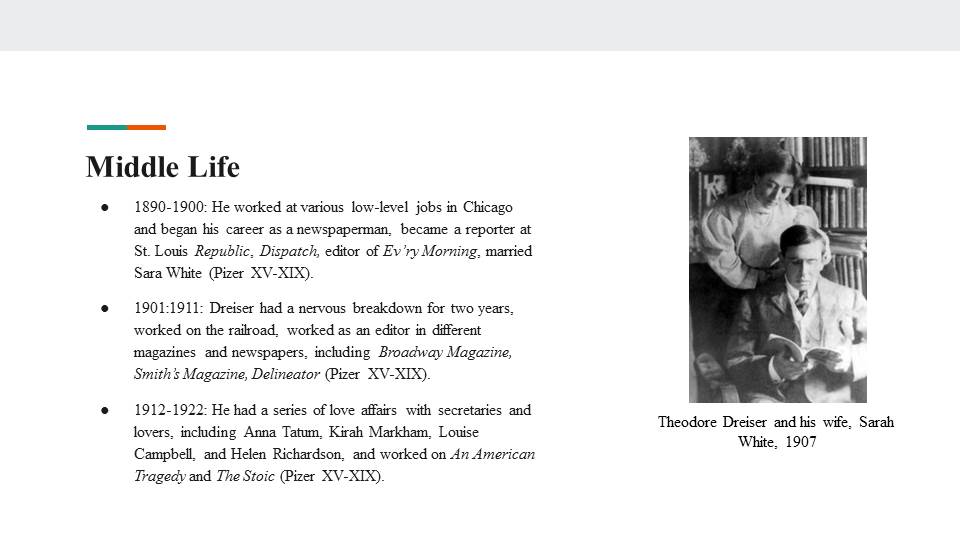
Later Life
- 1923-1933: He had a conflict over An American tragedy film, traveled to Russia, began involvement with The American Spectator, a literary magazine (Pizer XV-XIX).
- 1933-1945: He had an anti-semitic affair at The American Spectator and later resigned; his friend George Douglas died and visited Spain and the International Peace Conference in Paris. In 1940, Sara died, and by 1943 he had poor health. In 1944, he married Helen and joined the Communist party. He died of a heart attack on December 28, 1945 (Pizer XV-XIX).
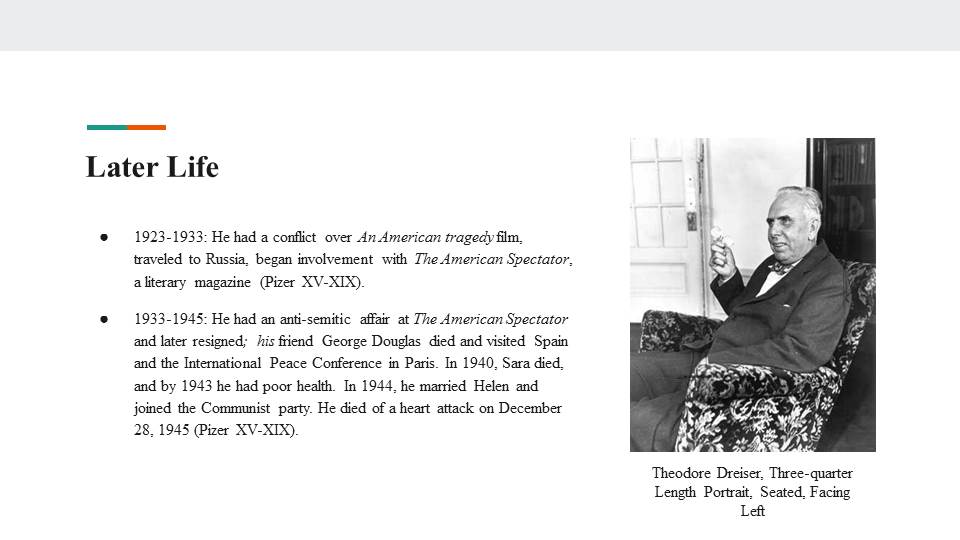
Popular Works: Sister Carrie
- Sister Carrie is Dreiser’s first published novel, in 1901.
- It depicts a young woman who moved to a big city to realize her American dream. The central theme characterizes the consequences of the misguided and misdirected pursuit of the American dream.
- This novel is one of the pioneering works that moved away from the Victorian emphasis on morals to focus more on realism. Dreiser depicted the life of the characters without ethical judgments.
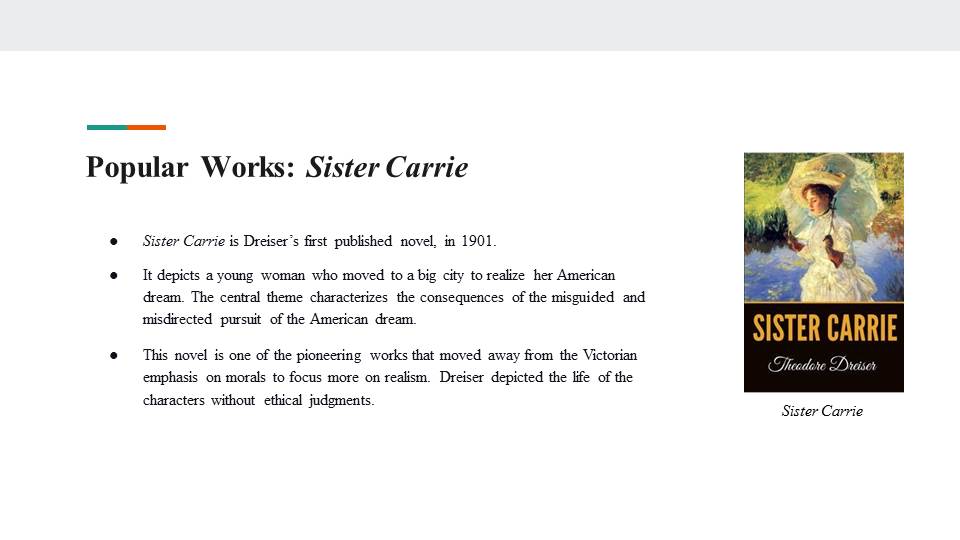
Popular Works: Jennie Gerhardt
- This work is Dreiser’s second novel, published in 1911.
- It depicts the life of Jenny Gerhardt, an impoverished, selfless young woman, and her tragic romance with a senator.
- In the novel, Jennie’s family highly reflects Dreiser’s own family: religiously fanatical father and pregnant unwed sister parallel Dreiser’s early life struggles.
- Dreiser confirmed that Thomas Hardy’s protagonist inspired his character in Tess of the d’Urbervilles.
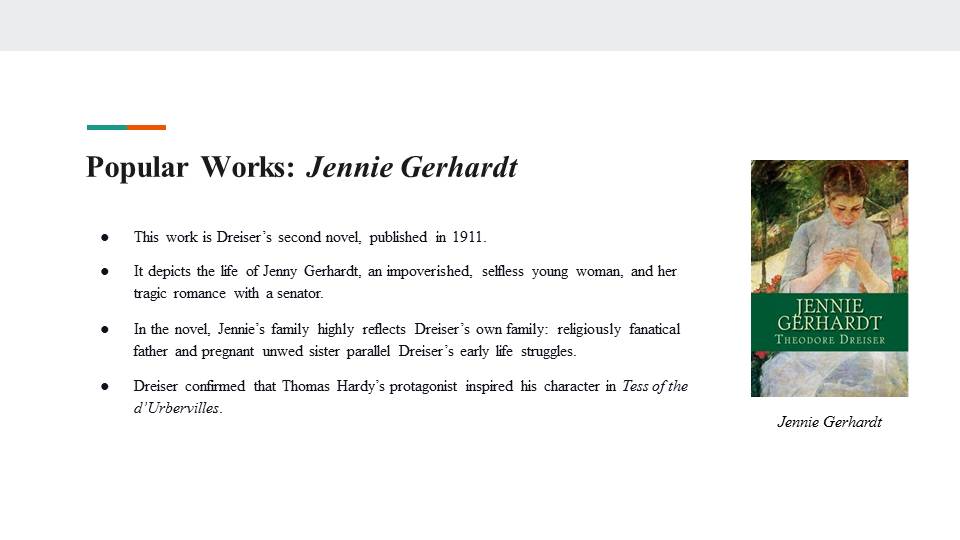
Popular Works: Trilogy of Desire
- The trilogy consists of three parts, TheFinancier (1912), The Titan (1914), The Stoic (1947).
- The protagonist’s life, Frank Algernon Cowperwood, was based on the real-life of Charles Yerkes, an American financier. He played a significant role in the development of a mass transit system in Chicago and London. The novel narrates the story of the protagonist’s self-centered quest for power and wealth.
- Each part of the trilogy derives from and reflects Dreiser’s experience of harsh poverty in the capitalistic US, shaping his yearnings for success and wealth.
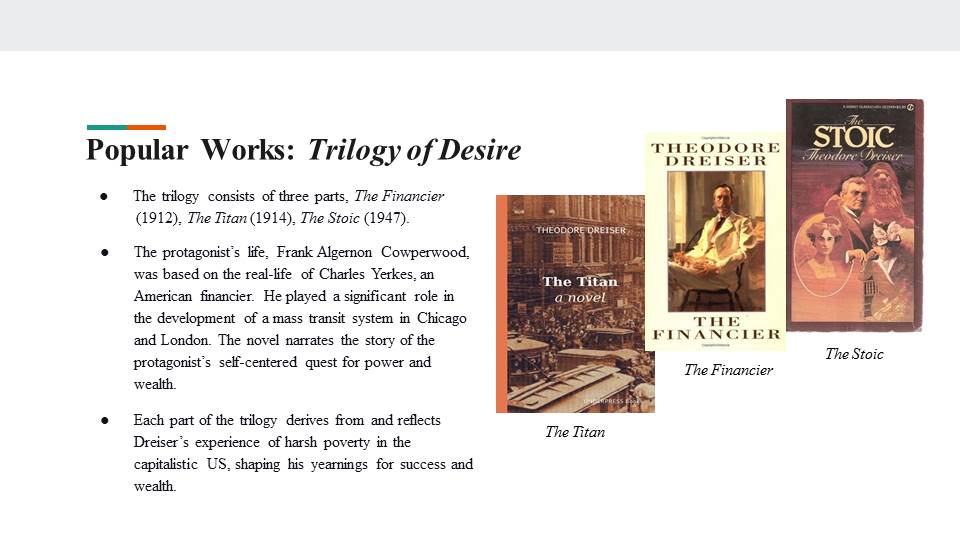
Popular Works: An American Tragedy
- This novel, which was published in 1925, narrates the real story of the murder of Grace Brown in 1906.
- This publication is his last accomplishment, but it is the first work to earn him legitimate literary and financial success.
- The novel was controversial and banned in 1927 due to sexual content, abortion, and murder.
- Once again, the differences in social class and economic inequalities become a significant theme in the novel. Hence, the book’s title in itself attempts to illustrate the inversion of the concept of the American Dream. The protagonist’s desire to move away from the spiritual teachings of his parents and pursue material success might reflect Dreiser’s same desire when he was young and living with his devoted Catholic family.
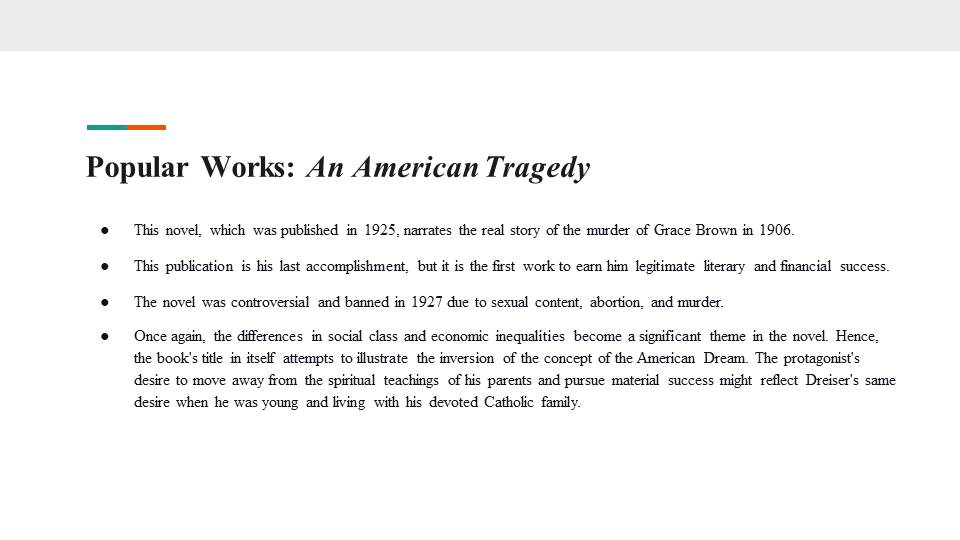
Intersection with Socio-Economic and Political Context
Several themes can be repeated identified throughout Dreiser’s novels that reflect on the realistic context of early twentieth-century America.
One of the most predominant themes is the social inequality between the very poor and extremely rich and how it shapes the lives of characters. The period when Dreiser wrote many of his works correlates with the period when the US experienced a rapid transition from agriculture to industrial economy, thus, forcing a new way of life and values for American people.
- Each of the character in his novels is either driven by, consumed by, or destroyed by capitalistic desire. While Carrie, Clyde, and Cowperwood strive for material success, Jennie is the victim of the success-driven American culture.
- By connecting the personal tragedy of characters with their social environment and political context, Dreiser reveals the truth about the destructive nature of capitalistic society and how flawed humanity produces flawed individuals.
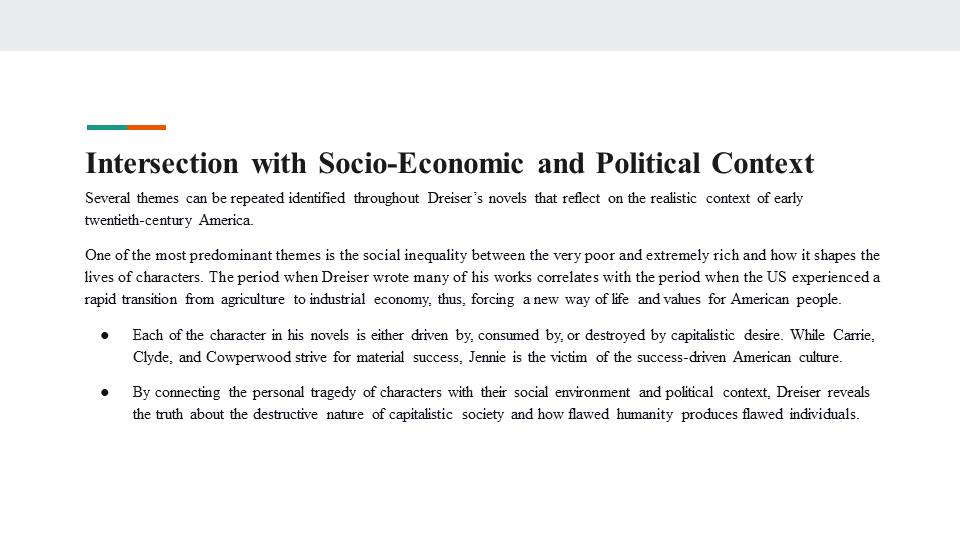
Capitalism and Class Distinction in Dreiser’s Excerpts
The excerpt from Sister Carrie illustrates the idea where “power and force” dominate and survive, while helpless and weak have to struggle:
“She walks bravely forward, led by an honest desire to find employment and delayed at every step by the interest of the unfolding scene, and a sense of helplessness amid so much evidence of power and force which she did not understand” (Dreiser 11).
Meanwhile, the excerpt from Jennie Gerhardt illustrates Jennie’s recognition of her poverty and her desire to be wealthy:
“Jennie fell to her task in silence, but the glamor of the great world was having its effect upon her senses. She could not help giving ear to the sounds, the brightness, the buzz of conversation and laughter surrounding her.” (Dreiser 7).
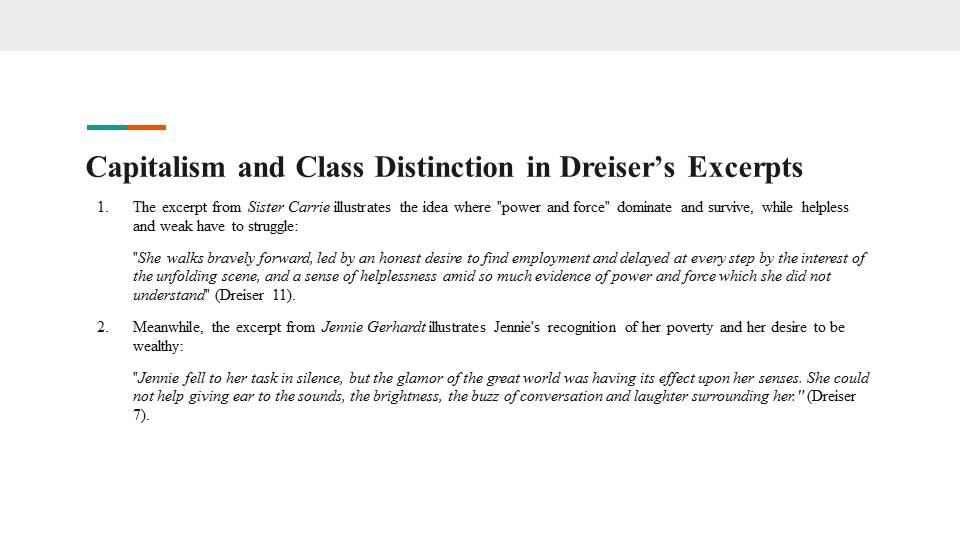
Literary Style and Influences
- Dreiser is very well-known for his naturalist style. This genre, which started in the late nineteenth century, reflects extreme realism, thus, narrating reality. Naturalism suggests that human character is shaped by their family, social conditions, and environment.
- Thus, Dreiser has a unique style that reflects the scrutinizing detail of the characters, their actions, and the environment surrounding them. His career as a newspaper journalist might have influenced his writing style. As a reporter, his main task was to report what happened, where, when, and by whom, in every detail.
- Herbert Spencer and Social Darwinism influenced his writing style. He believed that human beings are disabled in the face of the environment and the unfair competition where the strong wins over the weak (Zanine 7).
- He was also primarily influenced by the scientific thought that tempted him to reject his Catholic heritage (Zanine 8).
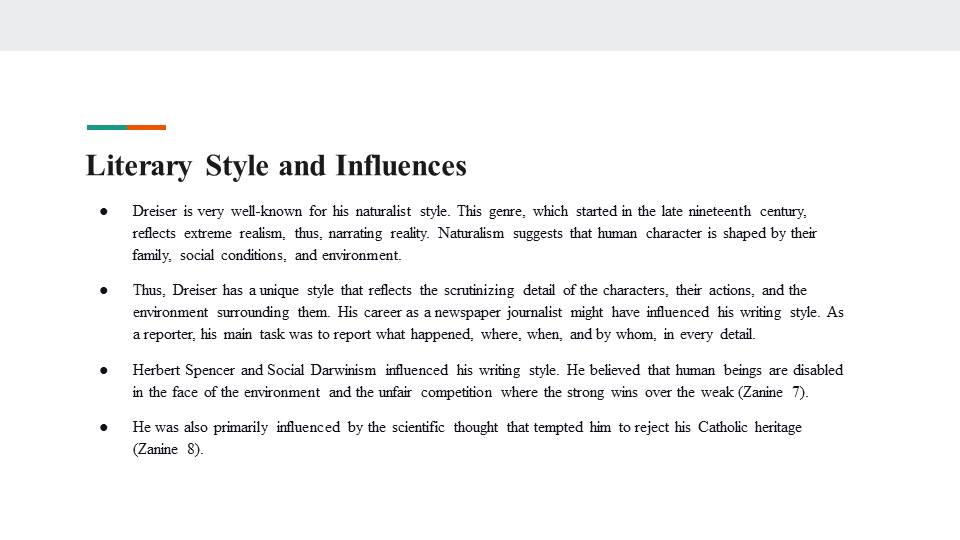
Conclusion
- Theodore Dreiser is one of the greatest authors in the history of American literature, who produced outstanding works that emphasized how social reality shapes the human experience.
- As a result of the association of religion with his tragic childhood and exposure to social Darwinist literature, he attempted to disassociate himself from any religious belief. He emphasized the strict, objective realities of humanity.
- Dreiser experienced severe poverty and social alienation in his childhood. America’s industrial and capitalist context, which glorified material success and individualism, shaped and intensified Dreiser’s beliefs and values revolving around wealth and social inclusion. Thus, throughout his life, these values remained and were reflected in many of his works.
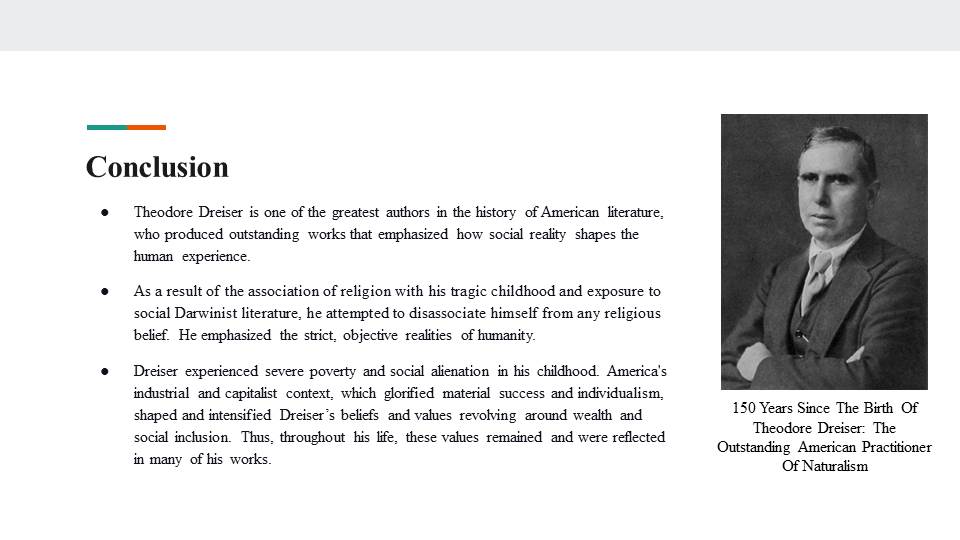
Works Cited
“The Financier”, Goodreads, Web.
“Jennie Gerhardt”. AbeBooks, Web.
“150 Years Since the Birth of Theodore Dreiser: The Outstanding American Practitioner of Naturalism”. CorD Magazine, 2021, Web.
Pizer, Donald. Theodore Dreiser Recalled. Liverpool University Press, 2017.
“Sister Carrie”. Tattered Cover Book Store, Web.